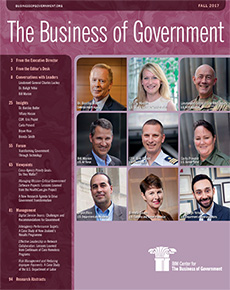
Leadership in Action: Fall 2017 The Business of Government Magazine

This edition of The Business of Government magazine provides a glimpse into the many different missions and programs of the U.S. federal government. It does so from the perspective of the mission leader, offering a snapshot-in-time discussion around challenges faced, innovations pursued, and initiatives yet to yield their desired outcomes. These are leadership stories that introduce you to those on the front line charged with delivering
the business of government.
Along with telling the stories of actual government leaders, I also present insights and actionable recommendations from some of the best minds in public management research—focusing on key challenges facing government today. As with every issue of this magazine, the fall 2017 edition underscores the fundamental mission of the IBM Center for The Business of Government: connecting research to practice.
“Research is collaboration,” writes Aaron Wildavsky. “The obligatory footnotes merely memorialize the fact that we are dependent on the work of others.” Whether we build on or amend or oppose it, the work of predecessors and contemporaries provides the indispensable frame within which we write. Constant conversation is the only way—and
the conjunction of idea and opportunity is critical. This is what I seek with each magazine.
Conversations with Leaders
If there is a constant theme that runs through these conversations, it is a singular focus on service: to country, to those who have made the ultimate sacrifice, and to mission.
The leaders I introduce manifest a commitment to making a difference and trying new and improved ways of doing just that. They reflect on the status of their strategic priorities, the challenges they face, and the work they do.
Lieutenant General Charles Luckey, Chief of Army Reserve and Commanding General,
U.S. Army Reserve Command discusses the mission of the U.S. Army Reserve, the essential components of force readiness, the Army Reserve’s support of civil authorities, and much more.
Bill Marion, Deputy Chief of Information Dominance and Deputy Chief Information Officer, U.S. Air Force (USAF) outlines the U.S. Air Force’s information dominance strategy and priorities, its modernization plan, and how USAF is changing the way it does IT.
Dr. Baligh Yehia, former Deputy Under Secretary for Health for Community Care,
U.S. Department of Veterans Affairs (VA) offers his perspective on the mission of the VA’s Office of Community Care, how VA has been enhancing community care, and what’s on the horizon for the Veterans Access, Choice, and Accountability Act (“Choice Act”).
Insights
During this transition year, I had the opportunity to speak with government executives who are changing the way government does business. In many instances, they are leading programs that are core to the Trump administration agenda ranging from trade to immigration to making government work smarter. Every presidential transition is marked by its own unique combination of continuity and change. The six government executives profiled here offer their insights into the work they do and the missions they lead.
Dr. Barclay Butler, Component Acquisition Executive, Defense Health Agency, U.S. Department of Defense provides insights into his agency’s efforts to make its acquisition and procurement functions more agile.
Tiffany Hixson, Assistant Commissioner, Professional Services and Human Capital Categories, Federal Acquisition Service, U.S. General Services Administration provides insights into her strategic leadership and oversight of FAS professional services and human capital contract programs, as well as government-wide professional services category management.
Commander Eric Popiel, Program Manager, U.S. Coast Guard (USCG) discusses advancing the use of strategic foresight at the USCG and promoting it throughout the U.S. federal government.
Carla Provost, Acting Chief, U.S. Border Patrol, U.S. Customs and Border Protection, talks about how the agency is continually identifying news ways to meet its mission and secure the homeland.
Bryan Rice, former Director, Office of Wildland Fire (OWF), U.S. Department of the Interior presents his insights into the work of OWF and its efforts to coordinate the fighting of wildland fires. Since our discussion, Bryan has been promoted to Director of the Bureau of Indian Affairs. From the Editor’s Desk
Brenda Smith, Executive Assistant Commissioner, Office of Trade, U.S. Customs and Border Protection shares her insights into the national strategy for the facilitation of legitimate trade and efforts to strengthen comprehensive trade enforcement.
Forum on Transforming Government Through Technology
By implementing private sector cost reduction strategies and technologies, the federal government can reduce costs while improving services. This cost-saving objective is highlighted in The Government We Need released by the Technology CEO Council (TCC) and supported by the IBM Center for The Business of Government. This forum highlights the insights presented in the TCC report and the IBM Center’s Transforming Government Through Technology—a companion piece to the more detailed TCC report. It presents the key insights and recommendations that can assist government leaders in understanding how to best leverage and scale past successes to benefit citizens and taxpayers today and in the future. These insights are confirmed by many of the IBM Center’s past studies and reports that similarly examine opportunities for improving government operations by applying private sector strategies and innovations.
Viewpoints
John Kamensky ponders whether and to what extent cross-agency priority goals matter. Gwanhoo Lee and Justin Brumer detail lessons learned from the development of the HealthCare.gov website—lessons that may help future government software projects avoid similar challenges. Dan Chenok provides an overview of the IBM Center’s new research agenda that shall guide its work and focus for several years to come.
I close this edition with overviews of recent IBM Center reports. If you have not read these reports, we encourage you to do so by visiting businessofgovernment.org.
I hope you enjoy this edition of The Business of Government magazine. Please let us know what you think by contacting me at michael.j.keegan@us.ibm.com.



